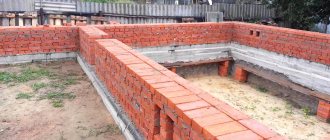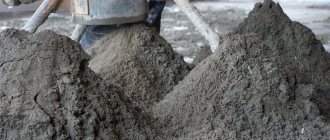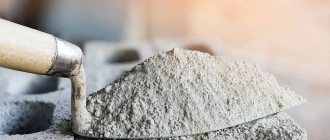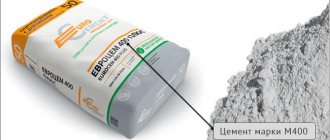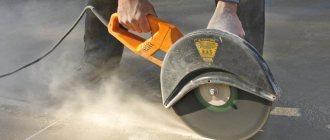1 min. to read
For construction, cement is almost always used, which is mixed in the right proportions with water and sand. This mixture is very viscous and allows you to connect bricks, stones, tiles, and concrete blocks. Cement mortar is used for:
- laying bricks;
- plastering surfaces;
- laying tiles;
- pouring the foundation;
- formation of paths.
If you don’t know how to mix cement, just familiarize yourself with the basic rules. It is not difficult to obtain a mass of the desired consistency.
To work with cement you need various equipment. Especially if large-scale construction is underway.
How to dilute cement correctly?
Cement is a special building material that acts as a “binder” between the components of concrete and cement mortar for various purposes. Cement in its pure form is practically never used. An exception is the technology of strengthening the top layer of concrete structures, the so-called “iron plating”.
In all other applications, cement is mixed in varying proportions with filler and mixer. Therefore, answering numerous questions from private developers, it makes sense in this article to tell you how to mix cement with sand, water and other components.
What happens if you dilute without sand?
Sand ensures reliable setting of the solution, serves as a binding element , and increases the strength of the resulting product. After hardening, the solution begins to crumble and collapse. Cement without sand can be used for minor repair work . Cement without adding sand can be used if you urgently need to treat small areas of floors, walls, facades, fences . Without filler, the solution will be less strong. After cooking, it hardens and turns into a fragile structure. Therefore, it is used only as a temporary measure when restoring the aesthetics of brick or concrete walls, for sealing cracks and pores, updating old structures, and reinforcing concrete.
Scope of cement application
To better understand the question of how to properly dilute cement, you should indicate the main ways of using this unique and irreplaceable building material:
- Production of heavy and other types of concrete.
- Preparation of masonry mortars.
- Preparation of different types of plaster solutions.
- Production of material for creating sculptures, flowerpots, flowerpots and other decorative products made of concrete.
- Production of paving slabs, curbs and paving stones.
Generally speaking, the use of cement can be divided into two main types:
- Binder for concrete of various types and purposes.
- Binder for solutions of various types and purposes.
Next, we will look at various formats and nuances of using the universal “binder”.
Proportions of popular brands of Portland cement for the production of heavy concrete
The most popular type of concrete in the construction of residential and industrial buildings, as well as the most popular material for the manufacture of all types of reinforced concrete products, is heavy concrete prepared on the basis of Portland cement grades M400 and M500, new markings: TsEM I 32.5N PTs and TsEM I 42.5N PC accordingly.
We present to our readers two tables in which you will find answers to popular questions: how to dilute cement for concrete using grades M500 and M400.
Table of proportions of components for preparing 1 m3 of heavy concrete of popular strength grades
| Brand of Concrete | Cement M400 CEM I 32.5 | ||||
| Proportions | Cement | Sand | Crushed stone | Water | |
| M100 | 1:4,4:6,5:1,1 | 175 kg | 755 kg | 1150 kg | 190 l |
| M150 | 1: 3,5: 5,2: 1 | 215 kg | 735 kg | 1140 kg | |
| M200 | 1: 3: 4,5: 0,7 | 255 kg | 715 kg | 1125 kg | |
| M300 | 1: 2: 3,3: 0,6 | 335 kg | 670 kg | 1105 kg | |
| M400 | 1: 1,5: 2,5: 0,5 | 420 kg | 625 kg | 1085 kg | |
| M500 | 1: 1,2: 2: 0,4 | 500 kg | 575 kg | 1065 kg | |
| Brand of Concrete | Cement M500 CEM I 42.5 | ||||
| Proportions | Cement | Sand | Crushed stone | Water | |
| M100 | 1: 5: 7,3: 1,2 | 160 kg | 770 kg | 1150 kg | 190 l |
| M150 | 1: 4: 6: 1 | 190 kg | 755 kg | 1140 kg | |
| M200 | 1: 3,3: 5: 0,8 | 225 kg | 735 kg | 1125 kg | |
| M300 | 1: 2,5: 3,8: 0,7 | 290 kg | 705 kg | 1105 kg | |
| M400 | 1: 2: 3: 0,5 | 355 kg | 675 kg | 1085 kg | |
| M500 | 1: 1,5: 2,5: 0,4 | 425 kg | 640 kg | 1065 kg | |
The table contains answers to one of the most common questions asked by non-professional developers of low-rise buildings - how to dilute cement for the foundation of a house, summer house or cottage.
In accordance with current regulatory documents - GOST and SNiP, the best option for pouring 99% of foundations is the grade of heavy concrete M150 or M200. For severe operating conditions, it is allowed to use concrete grade M400. Accordingly, when faced with the task of how to dilute a cement solution for pouring a foundation, you should use the proportions given in this table.
Many unprofessional and inexperienced developers ask the question: is it possible to dilute cement without sand, using existing granite screenings or small construction waste as a replacement for this material.
The answer of a private builder with sufficient experience in the construction of low-rise buildings and structures will be as follows. If it is necessary to build structures that are not heavily loaded, such as: a blind area around the house, a garden path, a platform for drying clothes or a one-story house made of furnace slag, an underground cellar of small dimensions (2x2x2 meters), a deviation from the existing GOSTs is allowed, in terms of replacing sand with small construction waste or small granite screenings.
How does a self-leveling floor differ from a leveler?
When searching for “self-leveling floor,” the search results in bathrooms and toilets with images of the jungle, clouds, or seabed on the floor. In practice, instead of paintings, masters pour some kind of gray liquid mixture.
A self-leveling floor is usually called a method of leveling horizontal surfaces when the plane is filled with liquid cement-based binder. Since the mixture is liquid, it always forms horizontally. A perfectly flat surface subsequently allows you to perform any type of finishing, from tiles to gluing prints with images.
Manufacturers often name these materials differently, which often gives rise to many misconceptions. For example, instead of the name “self-leveling floor,” the bag may say “self-leveling mixture,” “liquid leveler,” etc.
In the box: Knauf uses the name “self-leveling mixture”. Ceresit uses the phrase “thin-layer leveler”, Weber often uses the more familiar designation “self-leveling floor”.
Leveler the name can mean both a mixture for a self-leveling floor and a “classic” cement-sand screed.
Proportions for solutions
All cement-sand mortars are divided into three main types: material for laying bricks (cinder block, foam block, shell rock, Inkerman stone), mortar for plastering surfaces and mortar for floor screed. Let us consider the preparation of these solutions in order.
How to dilute cement for bricklaying? Two types of mortar are used in construction:
- Cement-lime material consisting of Portland cement CEM I 32.5N or CEM I 42.5N, carefully sifted sand, water and lime paste. This is the so-called “warm” solution. This type of material has excellent ductility and is considered optimal for all types of brickwork. Proportions of components: cement: lime: sand: water: 1 part cement, 0.8 parts lime, 7 parts sand, 0.8 parts water. First, the dry ingredients and lime are mixed, then water is added and everything is thoroughly mixed until smooth. If necessary, increase the amount of water.
- Cement mortar. Consists of Portland cement CEM I 32.5N PTs or CEM I 42.5N PTs, sand and water. Characterized as "cold, stiff and inactive." Component proportions: 1 part cement, 5 parts sand (for CEM I 32.5N PC) or 5.5 parts sand (for CEM I 42.5N PC) and 1 part water. The procedure for preparing the working material is similar to the procedure for preparing cement-lime mortar.
Types of gypsum
Gypsum is the first binder produced by man. Construction mineral binder is a powdery substance that, after mixing with water, turns into a plastic, flexible mass and gradually hardens to a stone state.
The basis of any construction is binders. They are used for the production of mortars and slabs.
Gypsum binder is an artificially produced binder by firing. It consists of semi-aqueous gypsum, which during heat treatment (105-200°C) turns into dihydrate:
CaSO₄*0.5H₂O → CaSO₄+2H₂O
Construction gypsum can be of either natural or industrial origin.
It is obtained both from natural gypsum stone and from chemical waste. The meaning of the operation is to exclude water (dehydration) from the gypsum composition as the temperature rises. Humanity discovered this simple method of production about 20 thousand years ago. People noticed that after firing, gypsum turned into powder, and then after rain it again transformed into stone.
According to the method of obtaining gypsum, there are α or β modifications.
To purify and obtain high-strength α-modification gypsum, the raw materials are heated in autoclaves without access to air under pressure at a temperature of 95-130°, water is removed by drip. The resulting semi-aqueous gypsum is characterized by high strength and quality. However, the high cost and difficulty of obtaining it affects its cost.
β-modification gypsum is produced in open kilns at higher temperatures of 150-180°C. Dihydrate gypsum is heated, the water turns into steam and, when leaving the raw material, forms a huge number of tiny pores, which significantly deteriorate its quality. Crushed β-modification gypsum is called building or alabaster. Molding gypsum is a β-modification of finer grinding, medical gypsum is made from good, clean raw materials with fine grinding.
The difference between alpha and beta modification gypsum is only in the production method and the result obtained.
Alabaster is a type of natural granular gypsum with a finer grain structure. Alabaster is classified as building gypsum, but any granular gypsum cannot be considered alabaster.
Alabaster is a fast-hardening binder material, which contains semi-aqueous calcium sulfate CaSO4 • 0.5H2O. It belongs to the β-modification gypsum because it is produced in open kilns.
Anhydrite is a naturally occurring anhydrous gypsum. It is characterized by long-term setting and hardening, it contains anhydrous calcium sulfate CaSO₄ and hardening activator CaO.
Estrich gypsum is produced by firing natural gypsum stone at t°=800-950°C. An additional substance during its dissociation is calcium oxide CaO, which acts as an activator of anhydrite hardening.
As a result of firing, two-hydrate gypsum is obtained, which has improved properties compared to conventional gypsum:
— Reduced water demand 30-35% versus the usual 50-60%;
— Long setting time: start no earlier than 2 hours;
— Highest strength 10-20 MPa after 28 days.
At the turn of the XIX-XX centuries. Estrich gypsum was used to obtain a base for a finished floor, masonry work, and the production of artificial marble.
Gypsum binders are substances based on semi-aqueous gypsum or anhydrite, which are called air binders.
They are divided into three groups depending on the production method:
- I binders subjected to heat treatment during their preparation: α or β modifications, calcium hemihydrate and soluble anhydrite.
- II binders without heat treatment: natural anhydrite.
- III binders from the first or second group, which are mixed with other components.
Representatives of groups I and II are non-moisture resistant (NHV), the bulk of representatives of group III belong to moisture-resistant binders (HB).
In turn, binders obtained by heat treatment are divided into low-firing and high-firing.
- The first include substances obtained at t°=120-180°C: building gypsum, including alabaster, molding, high-strength, medical gypsum. They have low strength and quick setting.
- High-burning binders include those obtained at t°=600-900°C: anhydrite cement, estrich gypsum and finishing cement. They are characterized by high density, strength and slow hardening.
Proven recipes for self-mixing concrete: print and use
When it is not possible to order a mixer with concrete, or you need to concrete structures of small volumes, self-mixing concrete comes to the rescue. The only question is how to cook it? At first glance, it seems that nothing is simpler. We take the “folk” proportion 1:3:5. That is, for one part cement, three parts sand and five parts crushed stone, add water “to taste.” Let's also pour some detergent into the concrete mixer. After all, everyone does it. And... voila, self-mixed concrete is ready. Do not hurry! Most often this leads to problems. The foundation filled with such self-mixing crumbles next year. The blind area cracks and the lintels burst. To prevent this from happening, read our article, which contains time-tested recipes for self-mixing concrete.
- Proportions of durable self-mixed concrete
- In what order should you pour the self-mixing ingredients into the concrete mixer?
- How much concrete can a concrete mixer mix at a time?
- Why concrete should be vibrated and not bayoneted
- Is it possible to add household detergents to concrete?
Introduction
back to top
Self-mixing is the process of creating vaping liquid from individual ingredients. The finished product that results is also called self-kneading. The etymology of this word is clear, and it accurately reflects the process: the steamer independently mixes propylene glycol, glycerin, flavoring, nicotine and water (not all components are required) in certain proportions.
Why does self-mixing even exist when the stores are full of a variety of liquids? Today, for e-liquids, both companies and ordinary vapers mainly use ingredients from the same manufacturers. Brands that produce e-liquids mix these ingredients into their own formula, bottle them and sell them to vapers. The price largely depends on the volume of the name and the beauty of the packaging, so when buying a branded liquid, the vaper pays mainly for the recipe and brand, and not for the ingredients themselves. This is why self-mixing is popular - you can always make a liquid for yourself much cheaper if you don’t want to pay for a name, or even create a unique taste that no manufacturer has yet invented. For example, the liquid “Herring under a fur coat” - no one has probably done this before.
In this article we will look at the ingredients for self-mixing and the effect of their proportions on the properties of the finished liquid. And in the second part, we will look step by step at the process of preparing liquid using a specific example and highlight the pitfalls of this process, as well as calculate the final cost of self-mixing.
Recipes for filling a concrete mixer
According to the rules, in order to prepare high-quality self-mixed concrete, you need to find the voids and moisture content of the sand and crushed stone that was brought to your site. Calculate the bulk density of cement and the density of cement mortar. Tell me honestly, who will do this on a real construction site? Especially if hired workers are building your house. Exit - print this article and use it as a cheat sheet when making self-mixed concrete.
I want to prepare self-mixing concrete. There is a 132 liter concrete mixer. I want to know the proportions of the concrete mixture for pouring the foundation for one batch, so as not to overload the concrete mixer.
FORUMHOUSE participants answer the question.
I am making a columnar foundation for a bathhouse. Concrete mixer for 130 l. Mixture proportions:
- 2.5 shovels of cement grade M500;
- 6 shovels of sand;
- 8 shovel granite crushed stone of fraction 5-20;
- some water.
When I trimmed the pillars to the level, the concrete was hardly sawed by a powerful grinder with a diamond blade with a diameter of 230 mm.
I concreted fence posts. The concrete was mixed like this:
- 1 bucket of cement M500;
- 2.5 buckets of sand;
- 4 buckets of crushed stone fraction 5-20;
- Less than a bucket of water.
I took the components of the mixture from the table below.
I came to a conclusion for myself: don’t skimp on mixing cement yourself! My proportions:
The concrete turns out to be so strong that it is difficult for a hammer drill to pick it up.
When making self-mixed concrete, the most important factor is the water-cement ratio! W/C is the proportion of the weight of cement and water used to prepare the concrete mixture. Along with the grade of cement, W/C determines the grade of concrete at the output. The water-cement ratio for the concrete mixture is given in the table below.
Another question was asked by a user with the nickname Serejik1987. He has a 155 liter concrete mixer. How to prepare M200 concrete in it, and how many buckets of components to fill for a full load.
If you measure in buckets, then it is recommended to fill a pear of this volume: 1: 2.8: 4.8, (cement-sand-crushed stone), but I recommend a different proportion - 1: 2: 3. As a last resort - 1:2.5:4. The main thing is not to overfill the water! To make the mixture workable, add a plasticizer.
But I’m wondering why, in a higher proportion, reduce the amount of aggregates? What does this give?
It is difficult to turn a mixture with a water-cement ratio less than 0.6 in a gravity concrete mixer. Rigid mixtures are processed using forced-action concrete mixers, but they are expensive. So you have to specifically choose proportions with a high cement content in order to end up with a foundation that will not fall apart in a few years.
And I prepare self-mix according to the recipe of the guys who make concrete pools. Proportions of concrete M350, on granite crushed stone of fraction 5-20:
- Cement M400 – 20 l or 25 kg.
- River sand, washed - 30 l or 42 kg.
- Crushed stone - 50 l or 67.5 kg.
- Water – 12 l.
- Superplasticizer – 0.2 l.
Previously, I poured the foundation in a ratio of 1:3:5, now I would do it myself in a ratio of 1.5:3:5.
Mix with liquid glass
Liquid glass is actively used as an additive in cement mortars . It accelerates hardening and increases resistance to moisture penetration. Liquid glass is a solution of sodium or potassium silicate, which is produced by high-temperature treatment of soda and quartz sand. Liquid glass is introduced into the solution during the construction of foundations, swimming pools, hydraulic structures, arrangement of furnaces, and screeding. It is indispensable for preparing plaster with high adhesion. Proportionally mixed glass and cement give the solution fire- and acid-resistant properties . The use of liquid glass requires concentration, because deviations lead to unpredictable changes in characteristics. The use of liquid glass is carried out in accordance with the following recommendations:
- The use of liquid glass as a waterproofing additive makes it possible to produce waterproof plaster. It is necessary to use a 15% composition, mix it with a sand-cement mixture in a ratio of 2.5 to 1.
- Waterproofing swimming pools requires observing the following proportion: one portion of silicate is required for 10 parts of the mixture.
- For a mixture of cement, sand and liquid glass, used as a protective composition in the manufacture of wells, the proportions used are 1:1:1.
- Concrete intended for solving household problems should not contain more than 10% liquid glass of the total weight of the solution.
- Preparation of coating compositions implies compliance with the following proportions: 1.5 parts of liquid glass, 1.5 parts of cement and 4 parts of sand, the share of water is no more than 1/4 of the volume of the additive.
- The preparation of ordinary concrete requires a concentration not exceeding 3% of the total volume.
Liquid glass. Photo by Maxidom
To prepare a solution with liquid glass, you must follow the following sequence of operations:
- a glass of silicate is added to one bucket of clean water;
- the components are mixed until the product is completely dissolved;
- during the stirring process, a dry cement-sand mixture is introduced;
- The mass is whipped until smooth.
It is important to remember that the duration of hardening is inversely proportional to the proportion of silicates in the composition.
In what order should you pour the self-mixing ingredients into the concrete mixer?
The volume of Lipon's concrete mixer is 180 liters. He loaded the pear like this:
- I filled in 11 liters of water.
- Then he threw 20 liters of crushed stone into the pear.
- Then 10 liters of cement.
- Added 20 liters of sand,
- I poured in 0.2 liters of plasticizing additive.
- I threw in another 20 liters of crushed stone.
- Now Liponya filled in another 10 liters of sand.
During the mixing process, we look at the density of the concrete. Add water from the remaining liter. At the finish we throw in 10 liters of crushed stone. The components were poured into 10 liter buckets.
I mixed concrete in a 160 liter concrete mixer. The mixture proportions are 1:3:4. I threw the ingredients in 12 liter buckets. Mesil like this:
- I poured 8 liters of water into the concrete mixer.
- Added liquid plasticizer to the water.
- I poured out all the rubble. It will be washed with water and removed dust.
- I filled in all the cement. I wait 3 minutes. If necessary, I change the angle of the pear.
- I filled up the 1st and 2nd buckets of sand. I am waiting. If the mixture is thick, add a little water.
- I pour out the 3rd bucket of sand.
FORUMHOUSE member 7profy shared the proven composition of concrete and the algorithm for pouring components into a concrete mixer.
I make concrete grade M250 in a 180 liter concrete mixer. Concrete composition by weight:
- cement M400 - 16 kg;
- river sand - 32 kg;
- crushed stone fraction 5-20 - 62 kg;
- water - 8 l.
- plasticizer - 250 ml.
Now, the same concrete volume in 8 liter buckets:
- cement - 1.5 buckets;
- sand - 3 buckets;
- crushed stone - 5 buckets;
- water - 1 bucket;
- plasticizer - 1 measuring cup.
Self-mixing concrete: blitz answers to the most popular questions from FORUMHOUSE users
1. What should you pour into the concrete mixer first: cement, crushed stone and sand, and then add water, or pour water first?
It seems to me that the components in a concrete mixer should be mixed dry and only then poured with water. So it is possible?
Try it! With this sequence, the mixture will turn out to be lumpy and the kneading time will increase greatly. If you start with water, then everything happens easier and faster.
Exactly! If you pour the dry mixture into a damp pear after the first kneading, it will stick to the walls and will not be washed away with water. You have to pick it out with a shovel.
First pour water, then add crushed stone, cement and sand. Look what happens: water washes away dust and dirt from the crushed stone. The cement is then crushed and mixed with crushed stone and water into a homogeneous slurry. Then everything is mixed with sand. With this method of mixing ingredients, no lumps or unmixed mixtures are formed. Just don’t add all the sand at once, but in small portions and make sure that the previous portion is mixed well.
2. How much concrete will a concrete mixer produce at one time?
I have a 63 liter concrete mixer. How much concrete will he mix at a time and how many components should he load into the bulb?
If you have a concrete mixer with a regular pear, then its useful volume is less than half. Even 30 liters is inconvenient to stir.
In a gravity-type concrete mixer, divide its total volume by 3. If the volume of the pear is divided in half, then excess concrete will fall out of the pear.
I read the following recommendations in the book “Concrete Worker’s Memo” for 1955: “Measure cement by weight, and the remaining parts by volume.” For 1 cubic meter of concrete it will take:
3. Should I bayonet or vibrate the concrete?
Bayoneting concrete is a useless exercise. I poured down the pillars and thought to make do with the means at hand. I attached a rod to the hammer drill and turned on the impact mode. Nothing at all. I bayoneted it, a little better, but still not the same. I went and bought the cheapest deep-throat vibrator. I poured concrete into the hole, turned on the tool and the concrete immediately went down and filled the entire volume. I recommend!
I also poured fence posts. The workers say: “We will pierce it in such a way that a vibrator could not even dream of!” Fine. They dumped 4 buckets of hard concrete into the hole. I tell them: “Bayonet!” They fought with concrete until they were blue in the face. They managed somehow. They swear that the mixture will not be compacted any more. He turned on the vibrator and wow, the concrete went down. A minute later they dumped another half bucket of concrete into the hole. Since then, the workers have cooled down to bayoneting.
conclusions
In the article we touched on the main issues related to self-mixing concrete. Now you can prepare it yourself and, taking a proportion of 1:2:3 (cement-sand-crushed stone fractions 5-20) with a W/C of 0.6 - 0.65, you can’t go wrong with strength. In conclusion, one more piece of advice from FORUMHOUSE:
This “folk” method is practiced when laying facing bricks, where high strength is not required from the mortar, but it is completely unsuitable for concrete. To increase the mobility of rigid concrete, use plasticizers. They are inexpensive, and you will see the effect immediately and without compromising the quality of concrete in the long term.
Everything you need to know about self-mixed concrete is collected in one topic: Do-it-yourself concrete: calculation of proportions, reinforcement, formwork.
- Formwork: which design is better or, How and from what to make formwork for the foundation so that it does not burst when pouring concrete.
- Are you tired of efflorescence on your brickwork? Find out why they appear, how to remove efflorescence from facing bricks, and what the consequences of ignoring this problem will be.
- We make an armored belt in a house made of aerated concrete. FORUMHOUSE offers a recipe for a formwork “pie” for making an armored belt in an aerated concrete house.
Source
